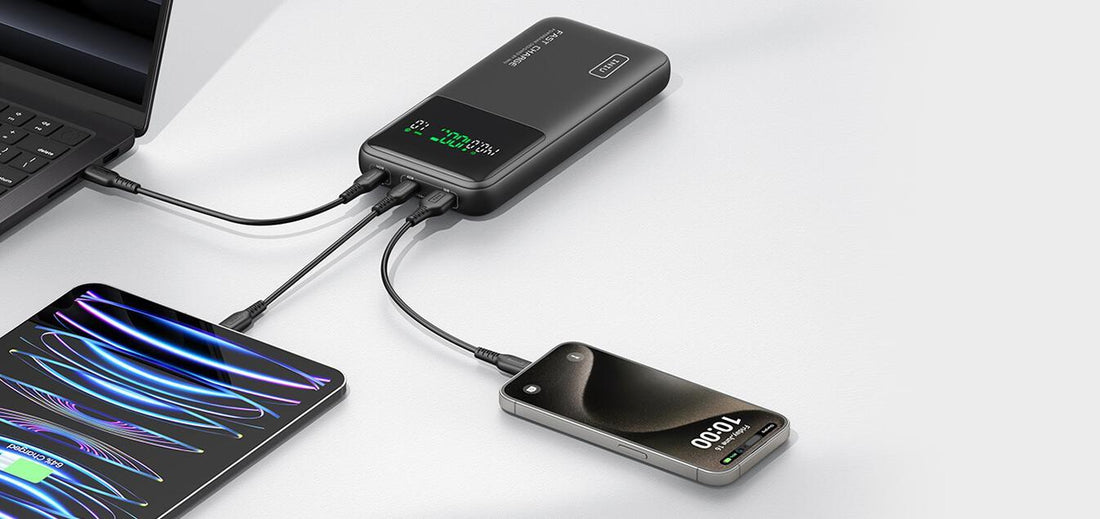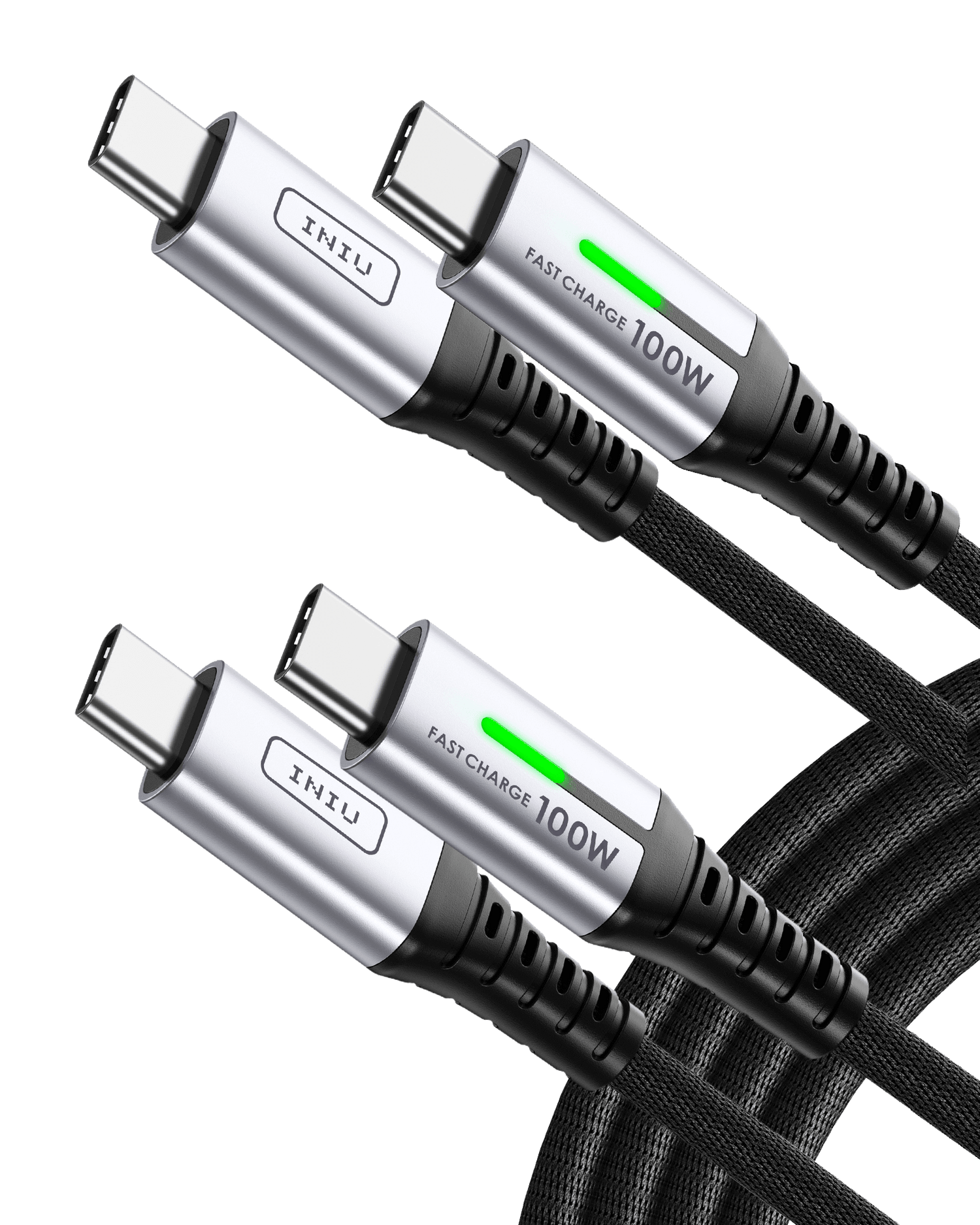
How to Choose the Best USB-C Power Bank: Wattage, Capacity, and Ports Explained
With most smartphones, tablets, and even laptops now supporting USB-C charging, many people assume that any USB-C power bank will get the job done. But that's not always the case.
Choosing the right USB-C power bank involves more than matching the connector. You need to evaluate wattage (charging speed), capacity (battery life), USB-C Power Delivery (PD) support, and the available ports, including whether there's a power bank inbuilt cable.
This guide walks you through how to pick the best type C power bank whether it's to keep your phone alive on daily commutes, power your tablet during travel, or give your laptop a backup boost when outlets aren't around.
Decide What You'll Charge: Phone, Tablet, or Laptop?

Different devices demand different levels of power. If your USB-C power bank doesn't provide enough PD wattage, your device may charge slowly—or not at all.
Smartphones (e.g., iPhone 15, Galaxy S24)
Look for at least 18W PD output
For faster charging, 20W–30W USB-C PD is optimal
Example: An iPhone 15 charges from 0% to 50% in about 30 minutes with a 20W USB-C PD power bank
Tablets & Gaming Devices (e.g., iPad Pro, Steam Deck, Switch OLED)
Need 30W or higher PD output for stable charging, especially during use
Laptops (e.g., MacBook Air/Pro, Surface, Dell XPS)
Require 45W minimum, ideally 65W–100W USB-C PD, 140W can provide laptop with full-speed charging with PD3.1.
A MacBook Air can run on 45W, but a MacBook Pro M2 may need 100W or more under full load
What's PD?
USB-C PD (Power Delivery) is a fast-charging protocol that allows smart power negotiation between the charger and the device. It enables optimized voltage and current delivery for safer and faster charging, especially important when using a USB-C pd power bank for laptops or tablets.
Check for True USB-C PD Output
Not all USB-C ports are created equal. Some USB-C power banks only use the port for input—meaning they charge themselves, but not your device.
How to Confirm Real USB-C PD Output:
- Look for specs like "USB-C PD Output," "PD 3.0," or "PPS"
- Check voltage/amperage ratings: e.g., 5V/3A, 9V/2.22A, 12V/1.67A
- Avoid models that don't clearly list PD or output wattage
Why It Matters:
A USB-C port limited to 5V/1A (5W) is too slow for modern phones and useless for tablets or laptops
Pro Tip: Choose a USB-C pd power bank that lists power output for each port. Advanced models that support PPS (Programmable Power Supply) can adjust voltage precisely for better thermal control and charging efficiency.
Choose the Right Battery Capacity for Your Lifestyle

Power bank capacity, measured in mAh (milliamp-hours), tells you how much energy it can store. However, the real-world usable charge depends on your devices and voltage conversion efficiency.
|
Capacity |
Best For |
Approx. Phone Charges* |
|
5,000–10,000mAh |
Light daily use |
1–2 charges |
|
15,000–20,000mAh |
Travel or multiple devices |
2–4 charges |
|
25,000–30,000mAh |
Long trips or laptop backup |
5–7 charges |
*Based on a typical 3,000mAh smartphone battery. Actual performance may vary.
Why You Don't Get Full Charge Count:
All USB-C power banks experience energy loss during conversion. A 20,000mAh bank might only deliver 13,000–14,000mAh of usable energy.
Flying with a Power Bank?
Yes, you can bring it, if it's under 100Wh. To calculate:
mAh × Voltage ÷ 1000 = Wh
Example: 27,000mAh × 3.7V = 99.9Wh → Safe for air travel
Ports & Cables: Make Sure It Fits Your Device Routine
How many gadgets do you want to charge simultaneously? Need backward compatibility with USB-A? Prefer a power bank inbuilt cable for cable-free convenience? USB-C power banks have different input and output port configurations. Let's take a look at what they are.
USB-C PD + USB-A Combo
- The most flexible setup
- Use USB-C PD for phones/laptops, USB-A for other devices like earbuds or watches
Dual USB-C Ports
- Great for charging two devices or charging and recharging simultaneously
- Make sure both USB-C ports deliver independent PD power—some models share power, slowing both outputs
Power Bank Inbuilt Cable
- Ideal for travel or emergencies
- Never worry about forgetting your cord
- Ensure the built-in cable supports 18W PD or higher
INIU Example: Some INIU USB-C power bank models feature built-in USB-C cables with PD and QC 3.0 support, combining speed and convenience.
What to Check
Does the USB-C port charge other devices, or only receive power?
Look for port specs like 5V/3A, 9V/2A, etc., for reliable fast charging
Safety, Reverse Charging & Real-World Compatibility

Safety should be a top concern, especially for high-capacity USB-C power banks. Poorly built models can overheat or damage your electronics.
Essential Safety Features:
- Built-in power management chips
- Protection against overcharging, overheating, short circuits
- Certification from labs like UL, CE, or FCC
Common Issues (and Fixes):
Reverse Charging: Some phones (e.g., iPhone 15) may attempt to charge the power bank if PD settings are misconfigured. Use only certified USB-C pd cables
Slow Charging: Can result from low-quality cables or underpowered multi-port usage
Loose Ports: Keep USB-C jacks clean—dust buildup can cause connection failure
Simple Fix: Stick with reputable brands, certified USB-C pd power bank models, and durable cables.
Click to view more detailed power bank safety guidelines.
Final Checklist: Choose Your USB-C Power Bank Wisely
|
Capacity |
Best For |
|
5,000–10,000mAh |
Light daily use |
|
15,000–20,000mAh |
Travel or multiple devices |
|
25,000–30,000mAh |
Long trips or laptop backup |
Use this guide to match power bank specs to your charging habits, ensuring your devices get the power they need wherever you go.
Buy Smart, Charge Smarter
The best type c power bank isn't just about having the highest capacity or price tag—it's about delivering safe, fast, and reliable charging that fits your lifestyle.
By understanding USB-C PD, selecting the right capacity, checking for real output wattage, and considering port flexibility (including power bank inbuilt cable options), you'll confidently choose a model that performs when it matters most.
Whether you're commuting, flying, or gaming on the move, trust a USB-C power bank with true PD output and robust build quality. Explore INIU's latest line of USB-C pd power bank options designed with safe airline-friendly capacity, dual fast-charging ports, and thoughtful features for everyday power users.



